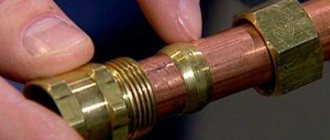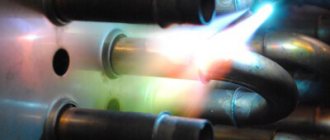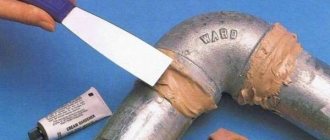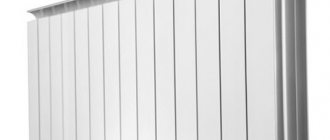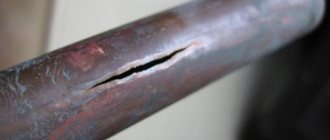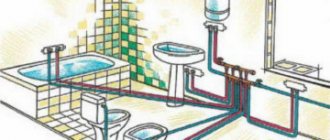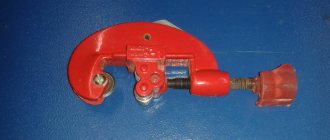Copper pipes are widely used in various engineering systems of houses and apartments. The main advantages of the material are resistance to corrosion and high temperatures, as well as UV radiation. In addition, copper pipes can be easily bent at any angle, making it easy to do it yourself.
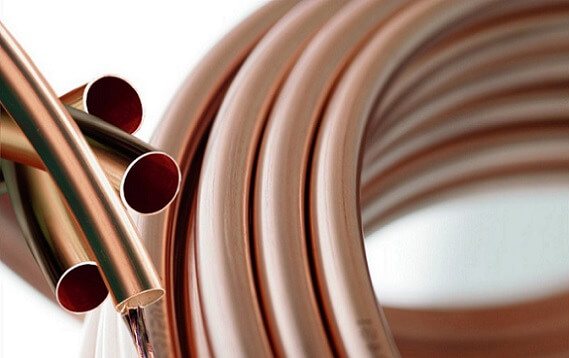
Copper pipes
As a disadvantage, it is often indicated that the material has a high cost, however, with such excellent characteristics of the metal, its price cannot be low. The installation of copper pipelines is carried out using fittings. They can be crimped or soldered, depending on this, the connection of copper pipes is also different. Compression fittings create a detachable connection, and solder fittings are one-piece.
Material characteristics
Copper pipe for water is a kind of rolled metal made of copper, which is a long-shaped hollow billet with a circular cross-section and a uniform wall thickness. It is produced in rods from 1 m to 6 m in length or in coils of 15, 25 and 50 m.
The diameter of the products varies from 6 to 267 mm, the wall thickness is from 0.5 mm to 3 mm. Despite the fact that copper tubular products have a thinner wall than steel, its inner diameter is larger, so it is able to withstand the same working pressure of the environment as steel products with a similar outer diameter.


The technical characteristics of copper pipes depend on the properties of the copper grade. Usually, in production, pure copper or its alloys are used, to which a small amount of alloying components (M1r, M1f) are added. The type and amount of impurities in alloys has a significant effect on the mechanical, technological, mechanical and operational characteristics of pipes.
The addition of zinc, tin, iron and lead increase the strength, elasticity and flexibility of the material, acidification with phosphorus increases the corrosion resistance of the metal. To increase the mechanical resistance and antifriction properties, aluminum and beryllium are used. To eliminate the negative impact of undesirable impurities, manganese is introduced into the alloy composition.
Regulatory requirements
The technical conditions for the production of thick-walled pressed and cold-worked copper tubular products are regulated by GOST 617-2006, drawn thin-walled GOST 11383-75. The high precision of manufacturing and finishing of copper pipes is determined by GOST 26877-2008 Metal products. Methods for measuring shape deviations. Primary copper grades and alloys must comply with GOST 859-2001. The chemical composition of alloys, assortment, technical requirements, marking, rules of acceptance, control and testing are established by GOST R 52318-2005.
Production
Seamless copper products are used for the construction of water supply and heating pipelines. They are manufactured using three technologies:
- Cold rolling - deformation of a metal blank occurs when passing between rotating rolls. A through hole is created using a stitching method. Then the sleeve is calibrated to the desired dimensions.
- Cold drawing - based on pulling the workpiece through a drawing tool (draw) with a special channel tapering along its length. In the process of drawing, the metal is compressed to the required geometric parameters and stretched along its length.
- Hot pressing - production of a pipe by extrusion (extrusion) through the die outlet.
In industrial production, one of these technologies or a combination of them can be used.The composition of equipment and technological operations may have some differences, but the main manufacturing process always consists of the following stages:
- Preparation of the workpiece.
- Cold rolling or drawing or hot pressing.
- Heat treatment.
- Lubrication of pipes and tools.
- Finished and intermediate products processing.
- Cutting into measured pieces or winding into coils.
- Quality control of finished products.
Installation
When installing a copper water supply system, it is necessary to take into account one of the main features of copper products - their plasticity. It simplifies installation work, as it makes it possible to bend pipe products and give the structure the desired configuration. However, such ductile pipelines can bend over time. To avoid this type of deformation, the water supply lines should be well secured with the help of supports or the installation of special fasteners (brackets).
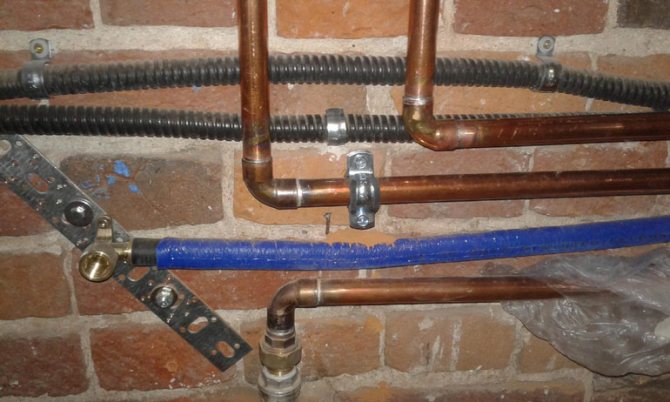

If the pipeline goes deep into the wall material, it is recommended to use PVC-sheathed copper pipes. It performs two functions at the same time: thermal insulation and anti-corrosion protection, preventing damage to either the pipeline or the plaster.
Equipment for the installation of copper pipes


The installation of a copper pipeline can be carried out in several ways. Previously, traditional welding or union nuts were used. This technology is still applicable now, but mainly when connected to shut-off valves or individual devices of the system. To increase the resistance to pressure and temperature, silicone or rubber gaskets, paronite and other types of materials used for these purposes can be used.
The installation of the water supply itself is carried out using press fittings, which make it possible to obtain the most reliable and durable connection. The only drawback in this case can only be a deterioration in appearance, which significantly limits the scope of these pipes. But this can be avoided by using the brazing of copper pipes, which allows to achieve a single integrity. In addition, this measure will improve the degree of reliability and extend the life of the product.
And the last thing worth noting is the ability to bend copper pipes at any angle. This is done using a special pipe bender or by preheating the pipe. Curved elements significantly overstate the cost of such a pipeline, but allow you to obtain an original decorative element. You can't do this with polypropylene pipes.
Looking to buy copper pipes for a pipeline? Visit the website mt-holding.ru
Pros and cons of copper pipes
Copper tubular products have the following advantages:
- High strength and wear resistance.
- Resistant to corrosion and UV radiation.
- High indicators of plasticity. Pipes bend well, which makes it possible to assemble structures without the use of fittings.
- Resistant to sudden temperature changes and pressure fluctuations.
- Frost resistance. Pipes do not collapse after freezing.
- Attractive appearance.
- Durability.
- Inertness in relation to aggressive environments.
- Heat resistance.
- Gas tightness.
- Environmental friendliness. Copper alloys do not emit toxic substances and are stable to oxidation.
- Antibacterial property.
- Light weight, easy to install and transport.
- No build-up on the inner walls occurs when the water flows.
The disadvantages of using copper pipes for a water supply system include:
- Quite a high cost.
- High electrical conductivity.
- Difficulty combining with other types of pipes (plastic, steel, aluminum).
- When connecting pipeline parts, special equipment (a gas burner or a soldering iron) and certain skills are required.
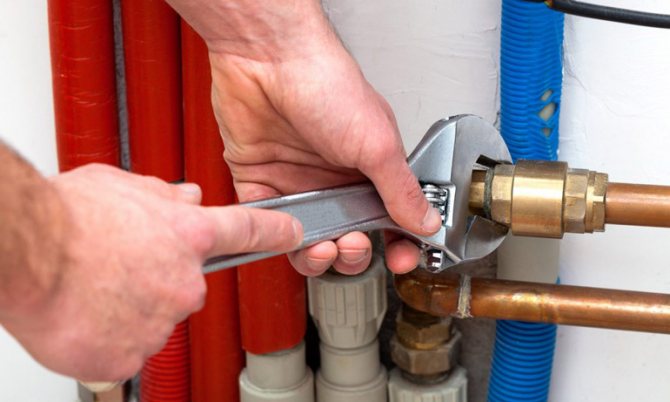

The main advantages and areas of use of copper piping
Copper pipes have an operating temperature from -200 to +250 degrees, as well as a low linear expansion, which allows them to be successfully used for such systems:
- Heating;
- Plumbing;
- Conditioning;
- Gas transportation;
- Receiving alternative energy, for example, solar systems.


Copper piping
When installing copper pipelines for supplying cold and hot water, there is no need to worry about overgrowth or silting of the inner section. Also, they are not destroyed by chlorine, which is added in high concentration to tap water. On the contrary, chlorine creates the thinnest protective layer on the inner wall of pipelines, which significantly extends the service life of the pipelines. In turn, a small amount of copper is released into drinking water, which has a beneficial effect on human health.
Views
Copper pipe is available in two types:
- Annealed - heat treated (annealed). The workpiece is heated up to 550 ° С - 650 ° С for 60 - 90 minutes, and then gradually cooled down (tempered), as a result of which it acquires elasticity, resistance to high humidity, sudden changes in temperature and pressure.
- Unannealed - more durable, but less elastic.
As thermal insulation and to prevent the appearance of condensation on the outer surface of the product, they can be covered with a polymer shell.
Equipment for the installation of copper pipelines
But let's not be distracted by beauty, let's get back to technical issues. There are several ways to connect copper plumbing parts.
Until recently, the main method (apart from traditional welding, which is complicated by the peculiarities of the material) was considered to be the connection with union nuts with pipe flaring.
This method is still used today, mainly for connection to shut-off valves or operating devices of the system. Temperature and pressure resistance is highly dependent on the gasket material. For these purposes, rubber, silicone, paronite and other types of materials are used.
Installation of a water supply system from copper pipes using press fittings allows you to obtain fairly reliable one-piece connections.
It should be noted that, unlike metal-plastic pipes, considerable efforts should be made to obtain a high-quality joint. Therefore, it is preferable to use pneumatic or hydraulic pressing tongs.
The disadvantage of the described types of connection is that the appearance of the laid line is significantly deteriorated. And this leads to a significant limitation of the scope. Therefore, mainly brazed copper pipes are used.
For capillary brazing, special types of burners and corresponding solders and fluxes are used. Of course, you can use an ordinary blowtorch, but without appropriate experience, it is possible to overheat the pipe with such a tool, which will negatively affect its performance.
Ample opportunities to reduce the number of joints, which not only improves the appearance, but also guarantees reliability, provides the ability to bend copper pipes at various angles.
To perform this action, you will need a special pipe bender, which can be operated without preheating the pipes. You can also bend the heated pipe, but this must be done using springs that will preserve the section and shape of the workpiece.
It is these bent elements that significantly increase the cost of a copper pipeline. If you want to get a stylish decorative element that will also perform the functions of a full-fledged water supply system, then your choice should still focus on copper pipes.
What is better copper or polypropylene pipes?
For an objective comparison, consider the basic indicators of both types of materials, typical for all water pipes:
- Operational properties. Copper, unlike polymeric materials, is not subject to the destructive effects of chlorinated tap water. Chlorine is a strong oxidizing agent that corrodes plastic, and on the inner surfaces of copper pipes forms a thin protective layer - a patina, which significantly increases their service life. Destructive for plastic is ultraviolet radiation and subzero temperatures, while copper is resistant to sunlight when the temperature drops. its walls expand without loss of integrity.
- System reliability. The joints of the elements of the plastic pipeline are less reliable than the copper one.
- Lifetime. Copper and polypropylene pipelines can be operated for at least 50 years.
- Price. The cost of copper products is high, this is due to the high cost of primary copper and the laboriousness of the production process. Of course, polypropylene pipes are several times cheaper. But, when assembling plumbing systems, polypropylene fittings are required, the cost of which is much more than copper fittings. In addition, plastic pipelines require additional elements to increase their reliability.
As a result, it turns out that the cost of copper plumbing is generally lower than plastic.
Features of copper pipes
Important advantages of copper communication networks are high strength, corrosion resistance, flexibility and ductility, durability of operation. An important feature of copper is the ability to eliminate some bacteria, which prevents them from multiplying and settling on the inner surface of the pipe.
When installing a pipeline with your own hands, it is necessary to take into account the following factors for choosing copper pipes:
- the purpose of the pipeline;
- temperature of substances to be transported;
- pressure in the water supply or heating system;
- pipe size;
- the presence of an insulating layer.
The disadvantage of copper pipes is low compatibility with products made from other materials.
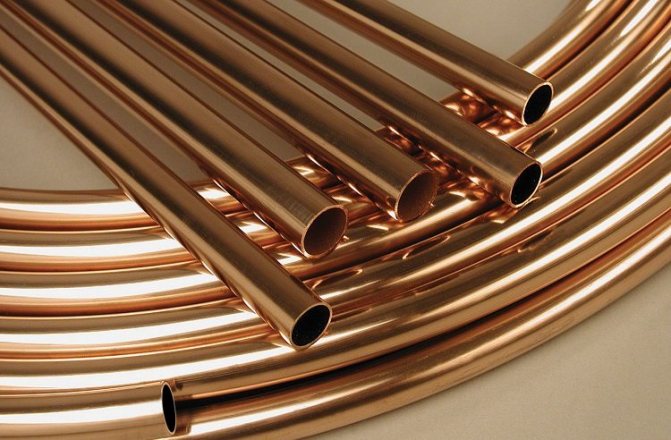

Copper pipes are the best option for plumbing
The most important characteristic that determines the technical parameters of the pipeline and the selection of the necessary fittings is the diameter of the copper pipe. In the construction of household systems, the most common are the following sizes:
| Pipe diameter, mm | Wall thickness, mm |
| 10-28 | 1 |
| 35-54 | 1,5 |
Important! At a thinner thickness, copper products have a much higher operating pressure than steel counterparts.
Larger systems require the installation of larger copper pipes.
Selection Tips
Unannealed copper rolled products are produced in measured lengths, and if it is necessary to make an extended and complex wiring with a small number of joints, then it is better to choose practical coils of annealed copper pipes of the same diameter and close in price. The performance of the system will not be affected when properly assembled.
approximate price
The cost of copper pipes depends on the following parameters:
- Sizes. The larger the diameter, the more expensive the product.
- Manufacturing firms. Products from European countries are 15-20% more expensive than their counterparts in Russia.
Copper tubular products are the most expensive of the entire range of materials for the construction of engineering networks. For example, with a diameter of 15 mm and a wall thickness of 1 mm, the price of a running meter will be 250 - 300 rubles.
Stages of laying copper pipes
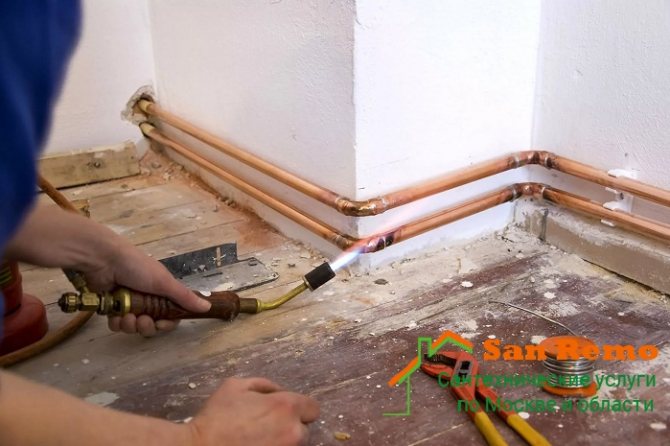

We carry out both open and closed copper piping. In general, the work plan is always the same and looks like this:
- Departure of a specialist to the customer's site.
- Inspection of the existing water supply system.
- Working out a plan for future wiring.
- Calculation of materials and terms of work.
- Dismantling of old pipes.
- Wall chipping (if the layout is hidden).
- Pipeline laying.
- Test run and check the system for leaks.
When the work is completed, qualified craftsmen give recommendations for further operation so that the completed wiring for the mixer or other equipment will serve the maximum period.
We have prepared good discounts for our clients:
- 5% when ordering services for up to 15,000 rubles.
- 8% when ordering work with a total cost of 15,000 to 20,000 rubles.
- 10% for those who order plumbing work from us for over 20,000 rubles.
- 10% for all pensioners, disabled people, WWII or Labor Veterans.
- 5% when ordering services online through the site form.
Connection methods
The installation of these products can be carried out in two ways: by threaded connection or by soldering. Copper and alloys formed on its basis can be joined by both high-temperature and low-temperature brazing. For water supply systems, low-temperature brazing is mainly used with the use of various solders, with the exception of lead-tin. They contain a large proportion of lead, which cannot be used for brazing drinking water pipelines.
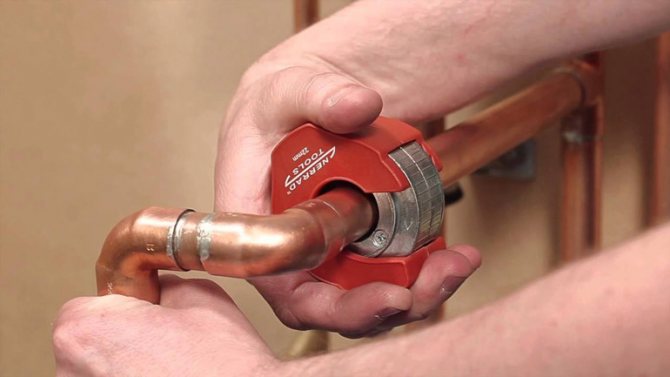

For the assembly of such systems, it is better to choose tin-copper or silver-containing solders. They create a good quality seam and meet all the requirements for the strength, reliability and durability of plumbing systems. As a flux, you can take a rosin-vaseline paste, which includes rosin, zinc chloride and technical vaseline. It has an easy-to-apply pasty consistency.
Installation of copper pipes for water supply
Before starting work, you need to draw up a diagram of the future plumbing structure and, on its basis, calculate the footage of rolled pipes and the number of connecting elements (press couplings, tees, bends, adapters, etc.).
Required tools and materials
To carry out the installation of rolled pipes made of copper alloy, you need to prepare a set of tools, consisting of:
- Hacksaws for metal or pipe cutters.
- Pliers.
- Manual calibrator.
- Wrenches or a gas burner (for heating the pipe section when soldering parts).
- File.
For joining pipe sections, depending on the selected connection method, the following materials will be required:
- Fitting.
- FUM - tape for sealing the joints of detachable fittings.
- Solder and flux (in the case of soldering products).
Precautionary measures
Soldering of copper products is carried out when they are heated to high temperatures, therefore, when working, it is necessary to wear protective clothing and use a fire shield. Remove rubber or plastic braids from the parts to be connected in the contact area. For taps to be installed, the valve must be unscrewed so that the O-rings do not melt.
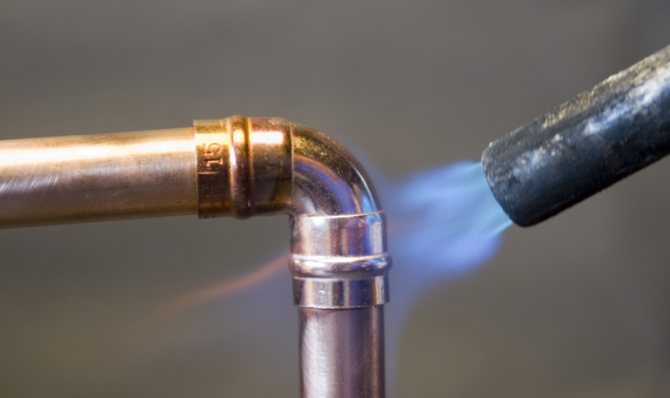

When soldering copper products in an already installed pipeline system, all shut-off valves should be opened so that the pressure level in the pipes does not exceed the permissible values due to heating of some areas.
Work progress
Docking of pipe sections using fittings is performed in the following sequence:
- Cut off pipe sections to the required size.
- If the water supply is assembled from copper pipes with PVC insulation, then this layer should be removed at the ends of the products.
- Deburr the cutting line with a file.
- Remove the chamfer.
- Put on the prepared part alternately the union nut and the compression ring.
- Engage the fitting with the nut and tighten the threads first by hand and then with a wrench.
- In places where the installation of a transition fitting from a copper pipe to a steel one is carried out, the tightness of the joints is ensured by the use of FUM - tape.
When connecting pipes by soldering with your own hands, you need to follow the precautions described above and have certain skills. The preparation process and the soldering itself includes the following steps:
- Cutting the required pipe sections using a pipe cutter or a hacksaw for metal.
- Removal at their ends of the thermal insulation layer (if any) and the formed burrs.
- Removal of the oxide film in the soldering zone with a fine abrasive cloth.
- Sanding the fitting.
- Flux coating on the outer surface of the parts.
- Insert the end of the pipe into the fitting so that there is a gap of no more than 0.4 mm between the parts.
- Warming up the contact zone of the gas burner elements (pictured below).
- Inserting solder into the gap between the fitting and the end of the copper pipe.
- Soldering the seam.
- Flushing the system from flux particles.
The process of brazing copper tubular products can be viewed in the video:
Installation features
Installation by soldering forms one-piece connections that do not require maintenance and are considered the most reliable in operation. But, in order to solder a copper water supply system, you must have sufficient experience in this type of work and relevant knowledge. Beginner masters can use the following recommendations:
- Do not clean copper products with abrasive cleaners, coarse sandpaper or a wire brush, as these will scratch the copper. Deep scratches on the surface interfere with the soldering process.
- Flux is a fairly aggressive substance with high chemical activity. You need to apply it in a thin layer using a brush. If surplus does not appear on the surface, at the end of the process of joining the parts, then they must be removed immediately.
- The contact zone should be heated sufficiently, but not excessively, so as to prevent the metal from melting. The solder itself should not be heated. It should be applied to the heated surface of the part - if it begins to melt, then you can start soldering.
- It is necessary to bend the pipes so as to prevent kinks and twisting.
- The installation of copper products should be carried out in front of aluminum or steel sections in the direction of the water flow to prevent rapid corrosion of the latter.
- For converting from copper pipes to sections made of other metals, it is recommended to use fittings made of brass, bronze or stainless steel.
The nuances of installing copper lines
Plumbers, with a set of tools and experience in working with copper, perform a number of actions during the installation of copper pipelines:
- stripping, calibration, cutting;
- giving the desired shape;
- compression, soldering, connection.
Each owner of an apartment or a private house can perform the same actions with his own hands.


The key to a high-quality installation of copper pipes using soldering is a thorough preparation for the process. The elements to be connected must be processed - cut to size, cleaned, fit the joint, thereby creating conditions for high-quality installation
The main thing is to learn the nuances of technology and the secrets of the production of such works. Each step requires the appropriate tool.
As a rule, the locksmith tool kit includes:
- copper pipe cutter or hacksaw for metal;
- files, sandpaper, rags;
- locksmith wrenches;
- gas wrench No. 1;
- manual calibrator, pipe bender;
- gas burner, flux, solder, tape fum.
The beginning of installation work is always preceded by measures aimed at calculating and drawing up a wiring diagram for a water supply or heating system.
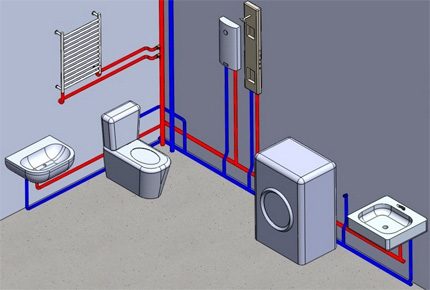

The presence of a wiring diagram for pipelines and connecting plumbing fixtures greatly facilitates installation work. The scheme allows you to accurately determine the financial costs of installation and rationally distribute the time for the execution of work
Based on their schemes, the required number of copper pipes, their length size, diameter, as well as the number of additional installation parts are calculated.
